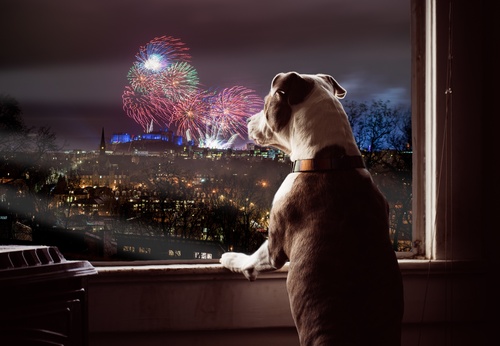Study on the impact of fireworks on our pets
How does your pet react to fireworks? What do you do to help your pet during this time? And has your pet ever disappeared during a firework display?

How does your pet react to fireworks? What do you do to help your pet during this time? And has your pet ever disappeared during a firework display?
The end of the year is approaching, and so are the New Year fireworks displays. While these dazzling displays fill humans with wonder, they can also be a major source of stress for our four-legged companions. That's why our Weenect survey explored animals' reactions to fireworks, seeking to answer several key questions.
The survey was based on a poll of over 652 Weenect customers in France, Belgium, Switzerland, Austria and Germany, including 476 dog owners and 182 cat owners. The survey gathered detailed information on their profiles, opinions and experiences regarding the impact of fireworks on their pets, and the measures they put in place during these shows.
It provided a better understanding of the effects of fireworks on our fur balls, offering valuable insights into respondents' behaviors and expectations.
Discover the detailed results of our study, through a series of lessons learned illustrated by graphs.
Our survey reveals that 26% of animals hide during fireworks displays, while 19.9% try to escape. A further 12.4% stayed very close to their owners, seeking comfort (see the graph for other reactions).
A minority of 9.3% of animals showed no particular reaction to the fireworks. On the other hand, 5.5% were curious about the noises, indicating an unusual interest.
Reactions vary between dogs and cats. Cats were more likely to hide (42.4%) than dogs (20.7%). Dogs panted more (14.9% compared with 3.5% for cats) and tried to flee more often (21.9% compared with 14.1% for cats).
According to our survey, 22.4% of owners have observed lasting effects of stress on their pets after a firework display. Dogs appear to be more affected than cats. Of the 476 dog owners surveyed, 24.2% confirmed that their pet was permanently affected. Among the 182 cat owners, 16.5% confirmed the same.
Among the lasting effects observed, anxiety is the most common (49.3%), followed by mistrust (20.7%) and loss of appetite (15.5%). Some animals also develop aggressiveness (8.6%) or an increased tendency to hide (5.9%). These lasting effects show up as a general fear of noise, refusing to go outside or showing increased distrust when out for a walk.
Our survey shows that 70.8% of owners choose to stay with their pets to reassure them during fireworks displays. Other owners try to distract their pet or cover up the noise (10%) or move their pet away from the source of the noise to a quieter area (8.2%). A few also resort to natural products (5.3%) or prescribed calming medication (4.8%).
The strategies adopted often depend on the animal's initial reaction. For animals that try to flee, 52.9% of owners move them away from the source of the noise. For those panting, 65.1% stayed with them to reassure them.
Our survey reveals that one animal in ten has run away during a firework display, highlighting the significant impact of these noisy events on animal behaviour.
Of the animals that went missing, 56.5% were found close to home (less than 200m away). This may explain why the vast majority were found quickly (78.3% were found within a few hours). However, of those found more than 3 kilometres away, only 60% were found within a few hours, and 33.3% took several days.
Faced with these missing pets, 75.8% of owners feel reassured by the use of the Weenect tracker during fireworks displays, which enables the animal to be located quickly if he runs away.
The survey shows that fireworks cause stress in the majority of pets, causing them to hide or run away. Nearly a quarter of pets suffer lasting effects such as anxiety, with dogs being more affected than cats.
Owners prefer their pets to be with them to reassure them, but 10% of pets still run away. The Weenect tracker appears to be a reassuring solution for quickly locating the animal in the event of a runaway.





